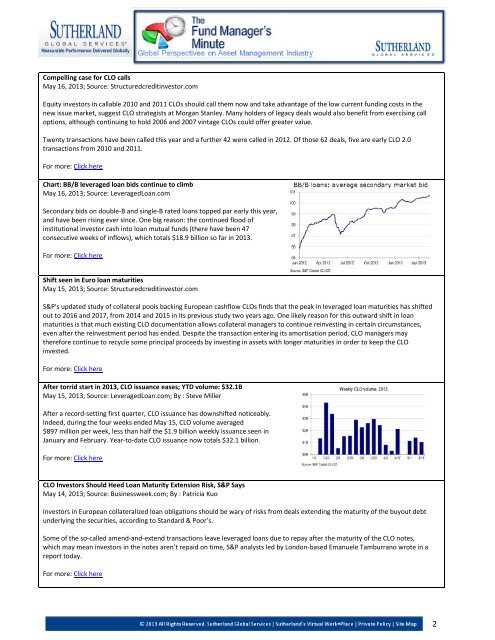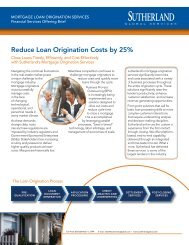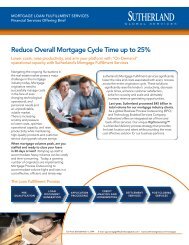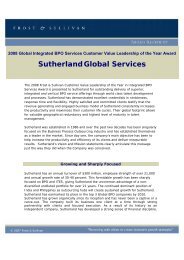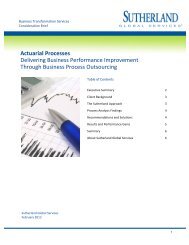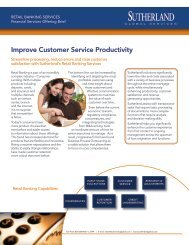CLO NEWSLETTER - Sutherland Global Services
CLO NEWSLETTER - Sutherland Global Services
CLO NEWSLETTER - Sutherland Global Services
You also want an ePaper? Increase the reach of your titles
YUMPU automatically turns print PDFs into web optimized ePapers that Google loves.
Compelling case for <strong>CLO</strong> calls<br />
May 16, 2013; Source: Structuredcreditinvestor.com<br />
Equity investors in callable 2010 and 2011 <strong>CLO</strong>s should call them now and take advantage of the low current funding costs in the<br />
new issue market, suggest <strong>CLO</strong> strategists at Morgan Stanley. Many holders of legacy deals would also benefit from exercising call<br />
options, although continuing to hold 2006 and 2007 vintage <strong>CLO</strong>s could offer greater value.<br />
Twenty transactions have been called this year and a further 42 were called in 2012. Of those 62 deals, five are early <strong>CLO</strong> 2.0<br />
transactions from 2010 and 2011.<br />
For more: Click here<br />
Chart: BB/B leveraged loan bids continue to climb<br />
May 16, 2013; Source: LeveragedLoan.com<br />
Secondary bids on double-B and single-B rated loans topped par early this year,<br />
and have been rising ever since. One big reason: the continued flood of<br />
institutional investor cash into loan mutual funds (there have been 47<br />
consecutive weeks of inflows), which totals $18.9 billion so far in 2013.<br />
For more: Click here<br />
Shift seen in Euro loan maturities<br />
May 15, 2013; Source: Structuredcreditinvestor.com<br />
S&P's updated study of collateral pools backing European cashflow <strong>CLO</strong>s finds that the peak in leveraged loan maturities has shifted<br />
out to 2016 and 2017, from 2014 and 2015 in its previous study two years ago. One likely reason for this outward shift in loan<br />
maturities is that much existing <strong>CLO</strong> documentation allows collateral managers to continue reinvesting in certain circumstances,<br />
even after the reinvestment period has ended. Despite the transaction entering its amortisation period, <strong>CLO</strong> managers may<br />
therefore continue to recycle some principal proceeds by investing in assets with longer maturities in order to keep the <strong>CLO</strong><br />
invested.<br />
For more: Click here<br />
After torrid start in 2013, <strong>CLO</strong> issuance eases; YTD volume: $32.1B<br />
May 15, 2013; Source: LeveragedLoan.com; By : Steve Miller<br />
After a record-setting first quarter, <strong>CLO</strong> issuance has downshifted noticeably.<br />
Indeed, during the four weeks ended May 15, <strong>CLO</strong> volume averaged<br />
$897 million per week, less than half the $1.9 billion weekly issuance seen in<br />
January and February. Year-to-date <strong>CLO</strong> issuance now totals $32.1 billion.<br />
For more: Click here<br />
<strong>CLO</strong> Investors Should Heed Loan Maturity Extension Risk, S&P Says<br />
May 14, 2013; Source: Businessweek.com; By : Patricia Kuo<br />
Investors in European collateralized loan obligations should be wary of risks from deals extending the maturity of the buyout debt<br />
underlying the securities, according to Standard & Poor’s.<br />
Some of the so-called amend-and-extend transactions leave leveraged loans due to repay after the maturity of the <strong>CLO</strong> notes,<br />
which may mean investors in the notes aren’t repaid on time, S&P analysts led by London-based Emanuele Tamburrano wrote in a<br />
report today.<br />
For more: Click here<br />
2


